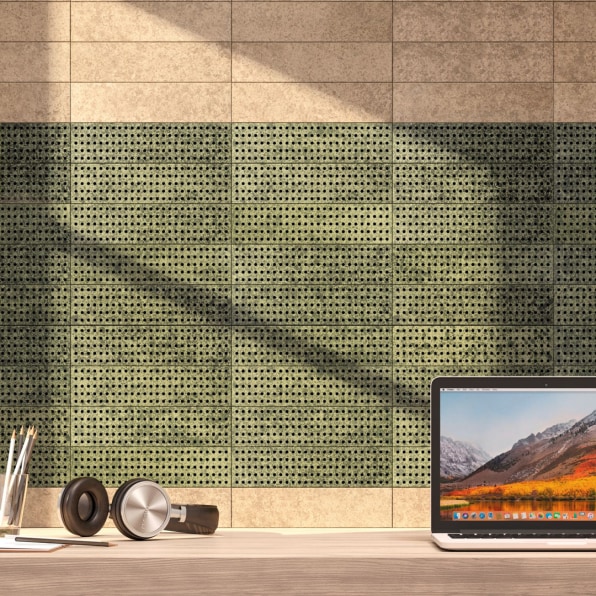
Did you know that about two-thirds of the fish that is caught is discarded as waste? Sometimes, fish waste like bones, heads, fins, and scales are used as fertilizers and fish oil, but much of it ends up in landfills. That is unless a materials researcher finds a way to reuse some of it and create an entirely new material—which is exactly what Erik de Laurens did when he created Scalite.

Made entirely from fish scales (or 99.5% of it), Scalite is a bio-sourced, biodegradable, and naturally nonflammable material that turns a byproduct of the fishing industry into a striking stone-like material that can make buildings a little greener, one tile at a time.
De Laurens built his first prototype while doing his masters’s in product design at London’s Royal College of Art in 2011. He then spent six years working as a materials researcher at architecture firm Foster + Partners, where he was faced with what he calls the “architectural problematics” and polluting reality of the building industry. In 2018, after two years of development, he moved back to his native France, partnered with entrepreneur Edouard de Dreuzy (who’s also his cousin), and the duo founded Scale as “an ocean-friendly brand.”
The French company’s first material is called Scalite. “We call it reversible, which means that with one tile of Scalite, you can produce another tile of Scalite,” says Laurens. Indeed the material’s natural composition—free of toxic chemicals, resins, and glues—means that when tiles are removed for a remodel, they can be 100% recycled.
Fish scales are a composite of biopolymers (collagen fibers) and minerals. During Scalite’s manufacturing process, this biopolymer is extracted and mixed with the mineral part of the scales to create the basis of the material, which is then mixed with a small quantity of a natural binder and dyes. The substance is then compressed into molds with a hydraulic press. The end result looks a bit like speckled Corian but with more vibrant hues like mustard yellow or moss green.

The product is currently available in two sets of tiles (rectangular and square), but the size of each tile is limited to about 12 inches-by-12 inches. “This is where it gets tricky because scaling up means bigger machines,” says Laurens, but custom applications are possible. He’s also working on a system to create a flexible sheet that would be draped over molds to create curved or wavy Scalite sheets.
The tiles can be used in a wide variety of interiors from restaurants and retail displays to homes. Sadly, though, they’re not yet recommended for use in wet areas like a bathroom. “It’s like MDF, it swells,” says Laurens, who recently hired a biochemist in the hopes of making the material water-resistant while staying true to the brand’s green credentials. “It’s tricky because the more water-resistant you are, the less biodegradable,” he says.
For now, Laurens says the biggest challenge in France is actually acquiring the scales in an efficient way. “In Europe, we haven’t got the recycling state of mind,” he says, noting that the recycling industry is only beginning to invest in special equipment to separate each fish byproduct—fish scales from skins, skins from heads, heads from bones—in a systematic way. For now, Scalite is made from fish scales collected in France from sustainably managed stocks of sardines or salmons, but because of the recycling complications, Laurens is looking to other markets with “more exotic scales” like Asian carp and sea bass, although the type of fish doesn’t affect the final color or texture of the product.
Lauren says the cost depends on the project, but starts at 300 euros per square meter (which equates to about $35 per square foot). He says white Corian and glass remain a little cheaper, but other stones, like marble, are much more expensive. “If you’re really serious about your environmental impact,” says Laurens, “then this is a really good solution because it’s basically natural.”

Author
Elissaveta M. Brandon (Fast Company)
Source
Scale Vision blog, press release, 2022-06-06.
Supplier
Share
Renewable Carbon News – Daily Newsletter
Subscribe to our daily email newsletter – the world's leading newsletter on renewable materials and chemicals












